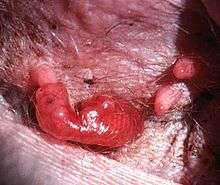Pouch (marsupial)


The pouch is a distinguishing feature of female marsupials (and rarely in the males as in the water opossum and the extinct thylacine); the name marsupial is derived from the Latin marsupium, meaning "pouch". Marsupials give birth to a live but relatively undeveloped fetus called a joey. When the joey is born it crawls from inside the mother to the pouch. The pouch is a fold of skin with a single opening that covers the nipples. Inside the pouch, the blind offspring attaches itself to one of the mother’s nipples and remains attached for as long as it takes to grow and develop to a juvenile stage.
Variations
Pouches are different amongst different marsupials: for example for quolls and Tasmanian devils, the pouch opens to the rear and the joey only has to travel a short distance to get to the opening (resting place) of the pouch. While in the pouch they are permanently attached to the nipple and once the young have developed they leave the pouch and do not return. The kangaroo's pouch opens horizontally on the front of the body, and the joey must climb a relatively long way to reach it. Kangaroos and wallabies allow their young to live in the pouch well after they are physically capable of leaving, often keeping two different joeys in the pouch, one tiny and one fully developed. In kangaroos, wallabies and opossums, the pouch opens forward or up. In koalas, wombats and marsupial moles, the pouch opens backward or down. Backwards facing pouches would not work well in kangaroos or opossums as their young would readily fall out. Similarly, forward-facing pouches would not work well for wombats and marsupial moles as they both dig extensively underground. Their pouches would fill up with dirt and suffocate the developing young one. Kangaroo mothers will lick their pouches clean before the joey crawls inside. Kangaroo pouches are sticky to support their young joey. Koalas are unable to clean out their pouches since they face backwards, so just prior to giving birth to the young koala joey, a self-cleaning system is activated, secreting droplets of an anti-microbial liquid that cleans it out.[1][2] In a relatively short time, the cleansing droplets clean out all of the crusty material left inside, leaving an almost sterile nursery ready to receive the tiny joey.
Some marsupials (e.g. Phascogales) lack the true, permanent pouches seen in other species. Instead, they form temporary skin folds (sometimes called "pseudo-pouches") in the mammary region when reproducing.[3][4][5]
See also
- For more about the nature and usage of the pouch, see Marsupials#Description
References
- ↑ Anna Salleh (2004-08-05). "Koala pouch may have its own bug buster". Australian Broadcasting Corporation.
- ↑ Gabrielle Bobek, Elizabeth M Deane (2002-03-26). "Possible antimicrobial compounds from the pouch of the koala, Phascolarctos cinereus". Letters in Peptide Science. doi:10.1023/A:1016257920016.
- ↑ http://www.arkive.org/brush-tailed-phascogale/phascogale-tapoatafa/
- ↑ http://www.marsupialsociety.org.au/keeping-marsupials-dasyurids.html
- ↑ http://jeb.biologists.org/content/205/24/3775.full.pdf
External links
-
 Media related to Marsupial pouches at Wikimedia Commons
Media related to Marsupial pouches at Wikimedia Commons
